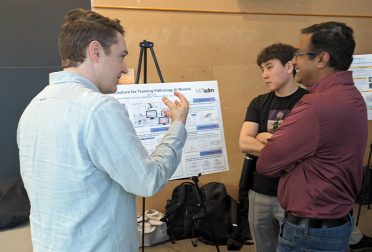by Stefanie Koperniak
When Ben Linville-Engler attended an event for the groundbreaking of a new MITRE bluetech facility in November 2021, he went on a tour led by Moise Solomon, technical director and division head of Electronic Systems at MITRE.
“I kept asking systems questions, and we quickly realized that we were both SDM alumni,” said Ben.
Ben was formerly the industry and certificate director for SDM and is now deputy director and chief investment strategist of the Massachusetts Technology Collaborative (MassTech). He also served as acting director of the Northeast Microelectronics Coalition (NEMC) Hub during its initial launch from September 2023 to February 2024.
MassTech was selected to lead and establish the NEMC Hub in September 2023 with funding stemming from the federal CHIPS and Science Act through the U.S. Department of Defense’s (DoD) Microelectronics Commons Program. The hub aims to advance the microelectronics needs of the DoD while also encouraging new jobs, workforce training opportunities, and investment in the region’s advanced manufacturing and technology sectors. MassTech convened and worked with a rapidly growing group of academic, industry, and other ecosystem leaders from the Northeast, including Ben and Moise. This group met almost weekly for over two years to identify common needs, challenges, regional gaps, and collaboration opportunities in preparation for the passage of the CHIPS and Science Act which enabled the proposal opportunity that resulted in the NEMC Hub.
“The role of the NEMC Hub at MassTech is to knit together a capability and capacity network that our Members can utilize to accelerate their work—bringing emerging microelectronics technologies from the lab to the fab,” said Ben.
After studying mechanical and biomedical engineering as an undergrad, he said he didn’t expect to be in this type of role in his career and that he has been leaning heavily on his embedded systems industry experience. SDM taught him to tackle challenges with a broader systems view which lends itself well to technology and innovation-based economic development. It’s also helped with navigating the once-in-a generation federal funding moment we are in known as the “Modern American Industrial Strategy.” As part of this strategy, the U.S. Department of Defense recently announced the Microelectric Commons awards to advance the development of microelectronic technologies. The NEMC Hub received six awards, more than any other regional hub. The awards total $37.8 million in funding for project teams in areas such as quantum technology and artificial intelligence hardware.
The NEMC Hub includes many regional partners across industry and academia, including MITRE.
“SDM aligns well with MITRE’s culture of being systems-oriented and valuing collaboration,” said Moise. “When creating something new, you have to think about the whole ecosystem—all the stakeholders involved—and not just what you’re trying to get out of it. You win through creating collaborations that are win-win.”
NEMC grant funds are allocated to selected initiatives aiming to grow a strong semiconductor workforce. For example, MITRE’s Collegiate Embedded Capture the Flag™ (eCTF) competition, funded by an NEMC grant, provides participating students with an opportunity to create secure systems—focusing specifically on embedded systems, which can present particular security challenges. The program runs over the majority of the spring semester and includes “design” and “attack” phases to balance offense and defense. For the 2024 eCTF competition, teams designed and implemented a supply chain security solution for microcontrollers on a medical device.
Ben and Moise credit the system architecture training emphasized in the SDM curriculum with providing useful tools and skills for thinking through the technical architecture of the hub, as well as its related projects. Both have found that the SDM program has helped them to identify the systems of systems that must be accounted for in such large and complex efforts, as well as develop important communications and leadership abilities—key to coordinating with many stakeholders involved. For the NEMC Hub, Ben and Moise have applied this systems approach to the broader “Modern American Industrial Strategy” of which the CHIPS and Science Act is a part, the NEMC Hub organization as a system, the regional capability and capacity network for transition pathways, and the multi-organization technical project proposals being developed within the Hub.
“A core benefit of SDM is gaining the capabilities to embrace, manage, and communicate complexity with a broader systems view,” said Ben. “These skills were critical in creating the Hub and are essential in ensuring that we are advancing the most impactful, high-quality proposals.”
Moise added, “NEMC Hub funding helped to make possible the installation of Applied Material equipment at MIT.nano, enabling important lab-to-fab work.”




